
The Mikoyan-Gurevich MiG-25 is a supersonic interceptor and reconnaissance aircraft that is among the fastest military aircraft to enter service. Designed by the Soviet Union's Mikoyan-Gurevich bureau, it is an aircraft built primarily using stainless steel. It was to be the last plane designed by Mikhail Gurevich, before his retirement.
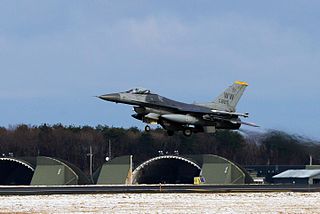
Misawa Air Base is an air base of the Japan Air Self-Defense Force (JASDF), the United States Air Force, and the United States Navy located in Misawa, Aomori, in the northern part of the island of Honshū of Japan. It is located 3 NM northeast of Misawa railway station, 4.8 km (3.0 mi) west of the Pacific Ocean, 16 km (9.9 mi) northeast of Towada, 29 km (18 mi) northwest of Hachinohe, and 684 km (425 mi) north of Tokyo at the "Tip of the Spear". It is a Pacific Air Forces (PACAF) facility with the 35th Fighter Wing as its host wing. It hosts both Japanese and American troops.

In politics, a defector is a person who gives up allegiance to one state in exchange for allegiance to another, changing sides in a way which is considered illegitimate by the first state. More broadly, defection involves abandoning a person, cause, or doctrine to which one is bound by some tie, as of allegiance or duty.

Viktor Ivanovich Belenko was a Russian-born American aerospace engineer and Soviet pilot who defected in 1976 to the West while flying his MiG-25 "Foxbat" jet interceptor and landed in Hakodate, Japan. George H. W. Bush, the Director of Central Intelligence at the time, called the opportunity to examine the plane up close an "intelligence bonanza" for the West. Belenko later became a U.S. aerospace engineer.

Hakodate Airport is an airport located 7.6 km (4.7 mi) east of Hakodate Station in Hakodate, a city in Hokkaidō, Japan. It is owned by the Ministry of Land, Infrastructure, Transport and Tourism and operated by Hokkaido Airports.

Firefox is a thriller novel written by Craig Thomas and published in 1977. The Cold War plot involves an attempt by the CIA and MI6 to steal a highly advanced experimental Soviet fighter aircraft. The chief protagonist is fighter pilot turned spy Mitchell Gant. The book was subject to a 1982 film adaptation produced and directed by Clint Eastwood who also played the role of Gant in the film.

Tonopah Test Range Airport, at the Tonopah Test Range is 27 NM southeast of Tonopah, Nevada, and 140 mi (230 km) northwest of Las Vegas, Nevada. It is a major airfield with a 12,000 ft × 150 ft runway, instrument approach facilities, and nighttime illumination. The facility has over fifty hangars and an extensive support infrastructure.

Burevestnik is a military air base on Iturup Island, Russia, establishing Soviet/Russian presence on the disputed South Kuril Islands with the largest airfield in the region. It is also the former Soviet Union's most remote interceptor base. An Army helicopter combat support squadron was also stationed at the airfield in the early 1980s, providing limited fire support and transport capability. Burevestnik's communications and logistics were tied to Yuzhno-Sakhalinsk and supplies were flown in weekly on Antonov An-12 aircraft.
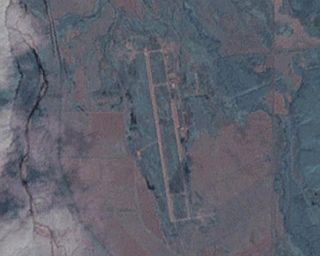
Chuguyevka is a military air base of the Russian Air Force in Primorsky Krai, Russia. It is located in Chuguyevsky District, near the towns of Chuguyevka and Bulyga-Fadeyevo, 190 kilometers (120 mi) north-east of Vladivostok. The base was also written in various references as Chuguevka, Sandagou, Sikharovka (erroneous), Sakharovka (erroneous), Sokolovka, and Bulyga-Fadeyevo.

Ibaraki Airport is an airport in the city of Omitama, Ibaraki Prefecture, Japan. It also serves as an air base for the Japan Air Self-Defense Force (JASDF) under the name Hyakuri Air Base, and is the closest fighter base to Tokyo. The airport was known as Hyakuri Airfield prior to March 2010, when civil aviation operations began.
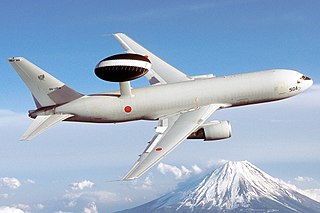
The Boeing E-767 is an Airborne Warning and Control System (AWACS) aircraft that was designed in response to the Japan Air Self-Defense Force's requirements. It is essentially the Boeing E-3 Sentry's surveillance radar and air control system installed on a Boeing 767-200.

Operation Diamond was an operation undertaken by Mossad. Its goal was the acquisition of a Soviet-built Mikoyan-Gurevich MiG-21, the most advanced Soviet fighter plane at that time. The operation began in mid-1963 and ended on August 16, 1966, when an Iraqi Air Force MiG-21, flown by the Iraqi Assyrian defector Munir Redfa, landed at an air base in Israel. Israel and the United States were able to study the design of the plane.

New Chitose Airport is an international airport located 2.7 nautical miles south-southeast of Chitose and Tomakomai, Hokkaidō, Japan, serving the Sapporo metropolitan area. By both traffic and land area, it is the largest airport in Hokkaidō.

Operation Moolah was a United States Air Force (USAF) effort during the Korean War to obtain through defection a fully capable Soviet MiG-15 jet fighter. Communist forces introduced the MiG-15 to Korea on November 1, 1950. USAF pilots reported that the performance of the MiG-15 was superior to all United Nations aircraft, including the USAF's newest plane, the F-86 Sabre. The operation focused on influencing Communist pilots to defect to South Korea with a MiG for a financial reward. The success of the operation is disputable since no Communist pilot defected before the armistice was signed on July 27, 1953. However, on September 21, 1953, North Korean pilot Lieutenant No Kum-Sok flew his MiG-15 to the Kimpo Air Base, South Korea, unaware of Operation Moolah.
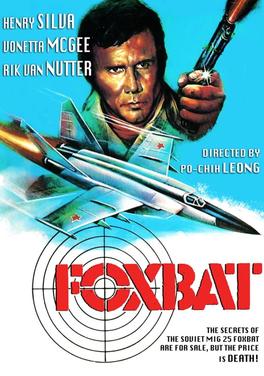
Foxbat is a 1977 action spy film directed by Po-Chih Leong, co-written by Terence Young, and starring Henry Silva, Vonetta McGee, Rik Van Nutter, and Roy Chiao. It is based on an original story by Philip Chan and Leong, and is based on the circumstances surrounding the defection of Soviet Air Force pilot Viktor Belenko and the capture of the MiG-25 “Foxbat” fighter.
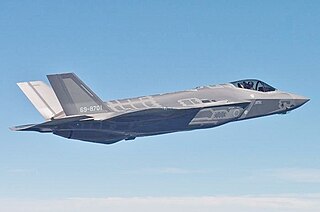
The 302nd Tactical Fighter Squadron 第302飛行隊 is a squadron of the 3rd Air Wing of the Japan Air Self-Defense Force (JASDF) based at Misawa Air Base in Aomori Prefecture in northern Japan. It is equipped with Lockheed Martin F-35A Lightning II and Kawasaki T-4 aircraft.
The 1987 Okinawan Tu-16 airspace violation was an incident on December 9, 1987 in which a Tupolev Tu-16P Badger J1 of the Soviet Air Force repeatedly entered Japanese airspace over Okinawa and Kagoshima prefectures. This prompted a F-4EJ Phantom fighter of the Japan Air Self-Defense Force (JASDF) to fire warning shots on two occasions. It was the first time aircraft of the JASDF had done so in response to an aircraft intruding in Japanese airspace. The Soviet Union apologized, claiming that the intrusion was accidental and due to meteorological conditions.

Violations of Japanese airspace have occurred on a number of occasions. There have been 39 cases from 1967 to 2017. The vast majority have involved Soviet aircraft during the Cold War, or Russian aircraft afterwards.
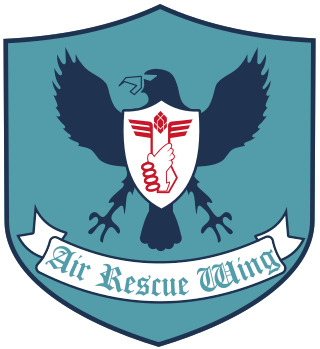
The Air Rescue Wing is a wing of the Japan Air Self-Defense Force. Responsible for airborne search and rescue, it is headquartered at Iruma Air Base in Saitama Prefecture and controls squadrons and detachments across Japan. The helicopter airlift squadrons were previously under the authority of Air Support Command. It is equipped with CH-47J, UH-60J and U-125A aircraft.























